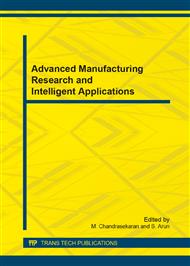p.180
p.184
p.189
p.193
p.197
p.202
p.206
p.211
p.215
Pulmonary Acoustic Signal Classification Using Autoregressive Coefficients and k-Nearest Neighbor
Abstract:
— Pulmonary acoustic signals provide important information of the condition of the respiratory system. It can be used to assist medical professionals as an alternative diagnosis tool. In this paper, we intend to discriminate between normal (without any pathological condition), Airway Obstruction (AO) pathology and Interstitial lung disease (ILD) pathology using pulmonary acoustic signals. The proposed method filters the heart sounds and other artifacts using a butterworth bandpass filter and windowed to 256 samples per segment. The autoregressive coefficients (AR coefficients) were extracted as features from the pulmonary acoustic signals. The extracted features are distinguished using k-nearest neighbor (k-nn) classifier. The classifier performance is analysed by using confusion matrix technique. A mean classification accuracy of 96.12% was reported for the proposed method. The performance analysis of the knn classifier using confusion matrix revealed that normal, AO and ILD pathology are classified at 94.36%, 95.18% and 94.68% classification accuracy respectively. The analysis reveals that the proposed method performs better in distinguishing between the normal, AO and ILD.Keywords—Respiratory sound, AR coefficients, k-nearest neighbor, confusion matrix
Info:
Periodical:
Pages:
211-214
Citation:
Online since:
July 2014
Price:
Сopyright:
© 2014 Trans Tech Publications Ltd. All Rights Reserved
Share:
Citation:


